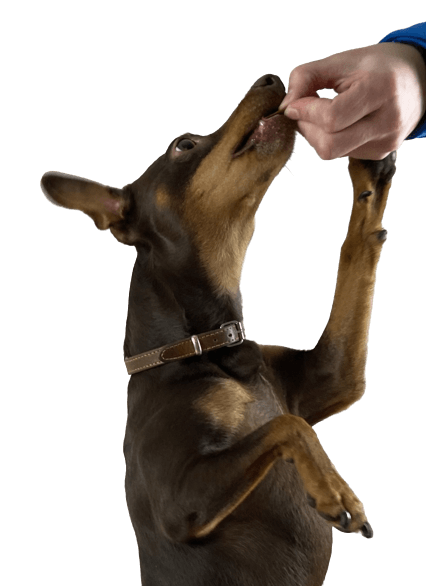Author: Evie Van Hove
My dog whines a lot: What does it mean and what can you do?
Crying, whining or squealing is a common behaviour in dogs that can express different emotions and needs. It can range from a way of seeking attention to a sign of discomfort or stress. If your dog whines frequently, it can be frustrating for both you and your dog. In this blog, we explore why dogs howl, what the possible causes are, and how you can address this behaviour. We pay special attention to dogs that whine when you leave, a behaviour often linked to separation anxiety.
Why does my dog whine?
Dogs use howling as a form of communication. It is their way of communicating their needs, desires or emotions. There are several reasons why a dog may whine a lot, including:
- Attention-seeking Dogs quickly learn that howling can get their owner's attention. Whether it is food, a toy or just some extra cuddles, your dog may whine to get what he wants.
- Discomfort or pain Whining can also be a sign that your dog is uncomfortable or in pain. If your dog suddenly starts howling for no apparent reason, it is important to rule out medical problems by consulting a vet.
- Boredom Like humans, dogs can get bored, and howling can be a way of expressing their frustration or need for stimulation. Dogs that do not get enough mental or physical activity may exhibit this behaviour.
- Fear or stress Whining can be a sign of anxiety or stress, especially in situations that are frightening or unfamiliar to your dog, such as loud noises, strangers in the house, or a change in routine.
- Excitement Some dogs whine from excitement when they are expecting something fun, such as a walk or an encounter with other dogs.
My dog whines a lot when I leave: separation anxiety
A specific problem that many dog owners encounter is that their dog starts whining as soon as they leave the house. This behaviour often indicates separation anxiety, a condition where the dog experiences extreme anxiety when left alone. Dogs with separation anxiety may not only whine, but also exhibit destructive behaviour, such as chewing furniture or scratching at doors.
"One particular problem that many dog owners encounter is that their dog starts howling as soon as they leave the house."
Causes of separation anxiety
Separation anxiety can have several causes, including:
- Trauma or negative experiences: Dogs that have had a traumatic experience, such as being left at a shelter, may be more likely to suffer from separation anxiety.
- Lack of socialisation: Dogs not used to being alone may become anxious if they suddenly find themselves in a situation where they do not have company.
- Changes in routine: A sudden change in daily routine, such as a move, losing a family member, or a change in work schedule, can trigger separation anxiety.
How to recognise separation anxiety
Besides howling, other symptoms of separation anxiety to watch out for include:
- Excessive drooling or panting when getting ready to leave.
- Destructive behaviour, such as destroying furniture or scratching at doors.
- Unwetting in the house, even if your dog is normally well housebroken.
- An overly enthusiastic greeting when you return, as if you have been away for hours, even if it was only for a few minutes.
Solutions for excessive howling
- Offer sufficient stimulation Make sure your dog gets enough mental and physical activity. Long walks, playtime, and offering puzzle toys can help reduce boredom and prevent whining.
- Consistent training Train your dog to stay calm in different situations. Teach your dog to sit, lie down and stay still on command. Reward calm behaviour and ignore whining when it seems your dog is doing it to get attention.
- Dealing with separation anxiety If your dog suffers from separation anxiety, there are several steps you can take:
Desensitisation: Start with short absences and gradually build up the time. Let your dog slowly get used to the idea of you leaving and coming back without panicking.
Create a safe space: Some dogs feel better in a smaller, safe space such as a crate. Make sure the space is comfortable with a blanket and a toy.
Use calming aids: Calming pheromones, special food supplements, or a comfortable vest that gives your dog a sense of security can be helpful in reducing anxiety. - Consult a clinical behaviourist In cases of severe separation anxiety or if the howling does not improve despite your efforts, a clinical behaviourist can help. This expert can develop a tailor-made behavioural plan to reduce your dog's anxiety and help him learn to cope with your absence.
Conclusion
Whining is a normal behaviour in dogs, but when it becomes excessive or persistent, it can be a sign of an underlying problem. Whether it is attention-seeking, boredom, or separation anxiety, it is important to identify the cause of whining and take appropriate steps to improve your dog's well-being. In cases of separation anxiety, professional help from a clinical behaviourist can be essential to help your dog feel safer and more confident when alone. With patience, training and the right support, you can ensure that your dog is happy and calm both when you are with him and when you are away.
Evie Van Hove is PgD Clinical Animal Behaviour, certified puppy coach, dog trainer and behaviour coach. She has been business manager of Pettherapy.be since 2021.





